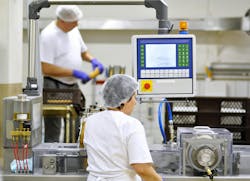They say you can’t please everyone all of the time. But US food and beverage manufacturers are facing increased pressure to meet the rising demand for personalized products. Here, Claudia Jarrett, US country manager at EU Automation, explains why automation is key to meeting these growing demands with fewer workers on processing lines.
US food and beverage manufacturers face a paradox. On the one hand, they are enjoying surging sales including growing demand from consumers. On the other, they face more demand than ever with fresh and healthy foods, and how these are sourced. According to research by ADM, the agricultural origination and processing company, the continuing COVID-19 pandemic has made people more people critical of where their food comes from and who makes it.
The health-conscious consumer is not a new trend. A key driver of this demand is Generation Z consumers, born in the mid-1990s to mid-2000s, who already make up 20% of the US population. Generation Z, reports Forbes, “have deeply formed perceptions and beliefs about anything related to being planet friendly, sustainable and eco-friendly.” Forbes adds that “Offering plant-based foods is just one element of an overarching strategy to appeal to today’s younger consumers.”
Generation Z wants natural, sustainable, and organic ingredients instead of generic, processed meals. With an estimated $200 billion of direct spending power—or $600 billion if we factor the influence of their parents—Generation Z’s spending power should not be ignored.
This brings us to the other side of the paradox: that food manufacturers must satiate this demand with a reduced workforce. On the one hand, this relates to the social distancing and safety requirements of the continuing COVID-19 pandemic. On the other, there is an ongoing labor crisis in the US that was apparent before the pandemic, and even worse now. The crisis threatens looming mass unemployment that could rapidly transform the food and beverage industry.
What can be done to handle customers’ demand for sustainable and ethically sourced foods? Manufacturers must embrace the potential of the Industrial Internet of Things (IIoT) to reduce maintenance costs, enhance productivity and open new revenue opportunities.
Passion for Fashion
How do smart factories keep up with changing consumer tastes? These new trends might entail complex processes, ingredients or the need for extremely precise equipment.
This is where Industry 4.0 and the smart factory will come into play. According to the Digital Factories 2020: Shaping the future of manufacturing report by Pricewaterhouse Coopers (PwC), digital technologies are gaining ground fast in helping works not only get more done but also improve processes and product quality.
One example cited by PwC is that companies are implementing tools to help workers better perform in-line quality checks and get the information they need when they need it, often using mobile apps that are independent of a particular workstation.
More brands are embracing blockchain technologies for greater transparency, to communicate the safety and quality of their products. This is confirmed in a survey by RSM, the multi-national network of accounting firms, which found that 12% of middle-market food and beverage companies now use blockchain technologies to track the entire lifecycle of food processing.
This figure will grow as costs of sensors have more than halved over the last decade, which makes adopting the IoT less expensive for today’s companies.
Icing On the Cake
Industry 4.0 technologies will become increasingly important as customer tastes and demands change, meaning that many manufacturers have to change recipes or even entire production lines to keep up with consumers changing taste buds.
For example, there’s real potential to embrace predictive analysis to control the quality of food along the value chain. Manufacturers can collect measurements of physical quantities through sensors, like temperature, steam pressure, and more, and turn these into digital data. This data can be stored in a memory that’s integrated into the sensor module, or transmitted for analysis via wireless or mobile networks.
The ability to resolve issues that have not yet occurred will be crucial in satisfying Generation Z consumers’ appetites for healthy goods on demand.
To implement these technologies, it’s also crucial to maintain a relationship with an industrial parts supplier. One example is EU automation, which supplies new, reconditioned, and obsolete industrial parts, allowing any part to be replaced. Stock items are shipped within 24 hours, ensuring minimal disruption to the production line.
While it will never be possible to please all of the people, all of the time, automation offers a multi-focal solution for food and beverage manufacturers to meet the growing demand for products by increasing production while also balancing food safety, product quality, and integrating changing tastes and trends.
About the Author

Claudia Jarrett
Head of Sales - The Americas, EU Automation
Claudia Jarrett is the Head of Sales for The Americas at EU Automation. EU Automation stocks and sells new, used, refurbished, and obsolete industrial automation spares. Its global network of preferred partner warehouses and wholly owned distribution centers enables it to offer a unique service within the automation industry, spanning the entire globe. It provides worldwide express delivery on all products meaning it can supply any part, to any destination, at very short notice.
